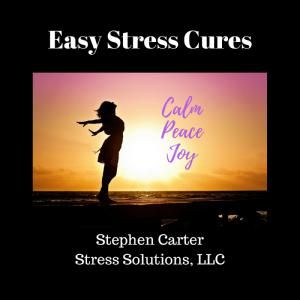How to Use Calming Sensory Building Blocks for Emotional Wellbeing

Jul 24, 2022 ·
21m 41s
Discover how to create calm and emotional peace and balance easily with the Calming Sensory Building Blocks method. --- Calming Sensory Building Blocks Procedure: - Sit comfortably in a chair...
show more
Discover how to create calm and emotional peace and balance easily with the Calming Sensory Building Blocks method.
---
Calming Sensory Building Blocks Procedure:
- Sit comfortably in a chair in an upright position with your non-dominant hand supported on the chair's armrest or in your lap. Allow your dominant hand to hang down toward the floor. If you feel any tension, shake the arm gently to release any obvious physical tension.
- Turn attention to your body and assess your beginning stress level using the 0 - 10 Subjective Units of Distress.
- Close your eyes look into your eyelids. You'll notice random arrangements of white, gray, and dark colors and shapes. As you allow your eyes to relax beneath your eyelids, you may experience a sense of going deeper into an ever changing pattern of light and dark. Simply notice whatever is there without judgement.
- After about 30 seconds, bring awareness to your dominant arm and hand dangling toward the floor. Isolate and bring attention to your index finger and notice any sensations. Cycle through the middle, ring, tiny fingers and thumb.
- After allowing your awareness to cycle through your fingertips, return attention to your eyes and notice whatever patterns are there for about 10 to 15 seconds.
- Next, bring attention to the sounds around you. Notice whatever sounds are present. As you continue to listen, you may notice faint sounds you didn't originally detect. Stay present and simply notice.
- After about 30 seconds, bring attention again to your eyes and notice the shifting patterns as you give attention to the visual sensory signals you notice with your eyes closed.
- When you're ready, return to normal awareness as you gently open your eyes and look around the area where you are sitting.
- Finally, give a yawn, sigh, and stretch and a final gentle deep in and our breath. As you exhale, say gently, "Peace".
- Assess your endings Subjective Units of Distress level on the zero to 10 scale.
- Repeat anytime to create a sense of emotional calm and wellbeing.
Resources:
Brainwave information sources:
"Introduction to Quantitative EEG and Neurofeedback": https://www.sciencedirect.com/book/9780123745347/introduction-to-quantitative-eeg-and-neurofeedback
https://www.researchgate.net/post/What-are-the-differences-in-EEG-brain-rhythms-when-eye-is-closed-and-when-eye-is-opened
"EEG differences between eyes-closed and eyes-open resting conditions": https://pubmed.ncbi.nlm.nih.gov/17911042/
Wikipedia: https://de.wikipedia.org/wiki/Berger-Effekt
---
Host:
Stephen Carter. Email: CarterMethod@gmail.com | Website: https://www.StressReliefRadio.com
---
Technical information:
Recorded and first edits with Twisted Wave. Noise reduction with Audacity. Leveled with Levelator. Final edits and rendering with Hindenburg Pro.
Microphone: EV RE320
---
Key words:
stress, stress response, relaxation response, relax, relaxation, calm, emotioal balance, meditation, emotional wellbeing,
show less
---
Calming Sensory Building Blocks Procedure:
- Sit comfortably in a chair in an upright position with your non-dominant hand supported on the chair's armrest or in your lap. Allow your dominant hand to hang down toward the floor. If you feel any tension, shake the arm gently to release any obvious physical tension.
- Turn attention to your body and assess your beginning stress level using the 0 - 10 Subjective Units of Distress.
- Close your eyes look into your eyelids. You'll notice random arrangements of white, gray, and dark colors and shapes. As you allow your eyes to relax beneath your eyelids, you may experience a sense of going deeper into an ever changing pattern of light and dark. Simply notice whatever is there without judgement.
- After about 30 seconds, bring awareness to your dominant arm and hand dangling toward the floor. Isolate and bring attention to your index finger and notice any sensations. Cycle through the middle, ring, tiny fingers and thumb.
- After allowing your awareness to cycle through your fingertips, return attention to your eyes and notice whatever patterns are there for about 10 to 15 seconds.
- Next, bring attention to the sounds around you. Notice whatever sounds are present. As you continue to listen, you may notice faint sounds you didn't originally detect. Stay present and simply notice.
- After about 30 seconds, bring attention again to your eyes and notice the shifting patterns as you give attention to the visual sensory signals you notice with your eyes closed.
- When you're ready, return to normal awareness as you gently open your eyes and look around the area where you are sitting.
- Finally, give a yawn, sigh, and stretch and a final gentle deep in and our breath. As you exhale, say gently, "Peace".
- Assess your endings Subjective Units of Distress level on the zero to 10 scale.
- Repeat anytime to create a sense of emotional calm and wellbeing.
Resources:
Brainwave information sources:
"Introduction to Quantitative EEG and Neurofeedback": https://www.sciencedirect.com/book/9780123745347/introduction-to-quantitative-eeg-and-neurofeedback
https://www.researchgate.net/post/What-are-the-differences-in-EEG-brain-rhythms-when-eye-is-closed-and-when-eye-is-opened
"EEG differences between eyes-closed and eyes-open resting conditions": https://pubmed.ncbi.nlm.nih.gov/17911042/
Wikipedia: https://de.wikipedia.org/wiki/Berger-Effekt
---
Host:
Stephen Carter. Email: CarterMethod@gmail.com | Website: https://www.StressReliefRadio.com
---
Technical information:
Recorded and first edits with Twisted Wave. Noise reduction with Audacity. Leveled with Levelator. Final edits and rendering with Hindenburg Pro.
Microphone: EV RE320
---
Key words:
stress, stress response, relaxation response, relax, relaxation, calm, emotioal balance, meditation, emotional wellbeing,
Information
| Author | Stephen Carter |
| Website | - |
| Tags |
Copyright 2024 - Spreaker Inc. an iHeartMedia Company
